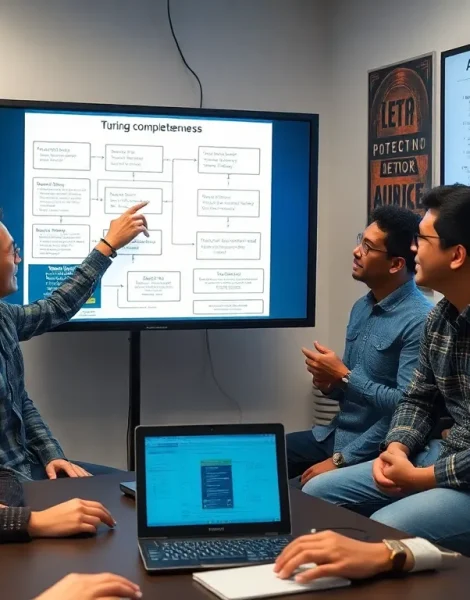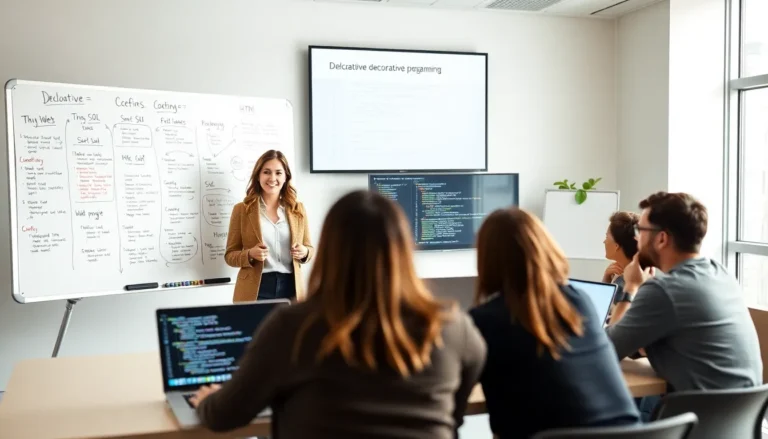In the realm of computer science, Turing completeness is the VIP pass to the world of computation. Imagine a magical land where machines can solve any problem, given enough time and resources. It’s not just a theoretical concept; it’s the backbone of what makes programming languages powerful and versatile. If you’ve ever wondered how your favorite apps manage to perform complex tasks, Turing completeness is the secret sauce behind the curtain.
Table of Contents
ToggleUnderstanding Turing Completeness
Turing completeness is a crucial concept in computer science that indicates a system’s ability to perform any computation given enough time and resources. This property allows programming languages to execute complex tasks and solve problems.
Definition of Turing Completeness
A system is Turing complete if it can simulate a Turing machine. Turing machines, developed by Alan Turing, are theoretical devices that manipulate symbols on an infinite tape according to predefined rules. Such systems can, in principle, execute any algorithm. Common programming languages, including Python and Java, are Turing complete because they can express any computational task. If a language lacks this property, it cannot compute everything, limiting its capability in solving various problems.
Historical Context
The concept originated from Alan Turing’s 1936 work on the Entscheidungsproblem, which aimed to determine whether a problem could be algorithmically solved. This foundational research established the principles of computation. Turing’s work paved the way for the development of modern computer science and programming languages. Over time, many systems and languages were evaluated for Turing completeness, helping shape the understanding of computation. The connection between Turing machines and programming languages continues to influence theoretical and practical aspects of computing today.
Importance of Turing Completeness

Turing completeness plays a crucial role in understanding computation and programming languages. Its implications extend deeply into both theoretical frameworks and practical applications.
Role in Theoretical Computer Science
The concept serves as a foundation in theoretical computer science. Researchers use Turing completeness to categorize computational systems, highlighting their capabilities to solve specific problems. It becomes essential for proving the limits of what can be computed. Scholars often reference Turing machines to demonstrate these principles. Various classes of problems, including decidable and undecidable ones, emerge from these discussions. Additionally, Turing completeness aids in evaluating the power of different computational models, such as finite automata and lambda calculus. The ongoing exploration of these areas continues to enrich the discipline.
Implications for Programming Languages
Turing completeness significantly impacts programming languages. Every complete language, such as Python or Java, allows developers to express any computable function. Programmers gain flexibility to implement algorithms using various constructs, including loops and recursion. This flexibility ensures that languages can tackle complex tasks across various applications. Furthermore, the existence of Turing complete languages empowers developers to create innovative software solutions. Recognizing this characteristic directs the design of new programming languages, ensuring they align with computational goals. Overall, Turing completeness strongly influences how languages evolve and adapt to meet user needs.
Examples of Turing Complete Systems
Turing complete systems can be found in various domains, notably in programming languages and other computational frameworks.
Programming Languages
Python ranks as one of the most popular Turing complete programming languages. It provides extensive libraries, supporting various applications from data science to web development. Java, another prominent language, enables developers to create complex applications across platforms. Languages like C++ and JavaScript also exhibit Turing completeness, allowing for intricate algorithm implementations. Each of these languages incorporates constructs like loops and functions, supporting any computable function.
Non-Programming Examples
Cellular automata exemplify Turing complete systems outside traditional programming languages. Conway’s Game of Life demonstrates how simple rules can produce complex behaviors, showcasing Turing completeness through its ability to simulate any computation. Another example includes certain configurations of a billiard table. These configurations enable the simulation of various algorithms based on the trajectories of balls, again illustrating the principles of Turing completeness. Even puzzle games, like the game of chess when theorized under specific rules, exhibit Turing complete properties, allowing for complex calculations within the game’s scope.
Limitations of Turing Completeness
Turing completeness has its limitations, particularly regarding certain types of problems and practical implementations.
Non-Computable Problems
Some problems remain unsolvable by Turing complete systems. The Halting Problem serves as a key example, illustrating the challenge of determining whether a program will finish running or loop indefinitely. Challenges also arise with problems that do not fit into formal computable frameworks, such as those involving real numbers and certain types of decision problems. Furthermore, specific mathematical problems, like the Riemann Hypothesis, illustrate instances of undecidability, where no algorithm can consistently provide a solution. These non-computable problems emphasize the boundaries of Turing complete systems.
Practical Constraints
Real-world limitations often impede Turing complete systems. Finite resources, such as memory and processing power, restrict execution in practice despite theoretical capabilities. High time complexity of algorithms can lead to infeasibility in solving real-time problems. Additionally, programming errors can prevent Turing complete systems from functioning correctly, further complicating practical implementations. Real-time constraints in systems, such as embedded programming, create situations where Turing completeness is less relevant. These practical issues highlight the gap between theoretical ideals and tangible applications in computational environments.
Turing completeness remains a cornerstone of computer science and programming languages. Its implications extend beyond theoretical frameworks to practical applications that shape the software development landscape. While it enables the execution of any computable function, developers must navigate the complexities and limitations inherent in real-world scenarios.
Understanding Turing completeness equips programmers with the knowledge to leverage its power effectively. By recognizing the boundaries of computability, they can innovate while remaining aware of potential pitfalls. As technology continues to evolve, the principles of Turing completeness will undoubtedly guide future advancements in computational theory and programming practices.









